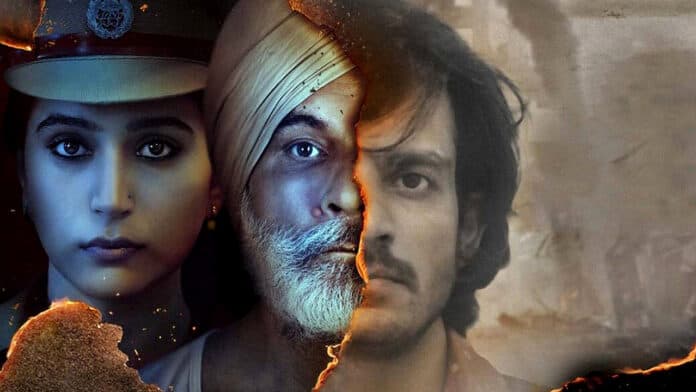Disney+ Hotstar’s ‘Grahan’ is essentially blooming a love story between two star-crossed lovers, Manu and Rishi, that succumbs to the anti-Sikh riots of 1984. However, the consequences of the doomed relationship entangle with the life of Amrita Singh, IPS officer, as she unravels the riddles of the past and the present, in 2016.
‘Grahan’ is inspired by the 2018 Hindi novel by Satya Vyas titled, ‘Chaurasi.’ It depicts the same story through two different perspectives, set in two timelines: 1984 and 2016.
The newly released series begins in Jharkhand 2016 with the abduction and murder of a young journalist. He was investigating and trying to discover the names responsible for the 1984 anti-Sikh riots in Bokaro. This uproar resulted in the death of numerous Sikhs after the news of the then Prime Minister’s assassination by her Sikh bodyguards broke.
Young IPS officer, Amrita Singh (Zoya Hussain) heads the new Special Investigation Team (SIT) set up by the Chief Minister as the election season in Jharkhand looms over. The SIT is asked to investigate the cold cases from the riots in Bokaro. However, this inquiry hits the protagonist’s home as she soon finds evidence of her father’s, Gursevak (Pavan Malhotra), involvement as one of the rioters.
Singh questions everything she has known about her father as his refusal to speak and the newfound traces of riots makes her desperate to uncover the untold truth.
On the flip side, the series also revolves around the love story of Rishi Ranjan (Anshuman Pushkar) and Manu aka Manjeet Chhabra (Wamiqa Gabbi). Amrita soon learns that it has an undeniable connection to the SIT case as she unearths the truth of what actually happened.
Grahan ending explained in detail:
The horrifying truth
Leading to the events of the last episode, we follow the journey of how the prime suspect for the riots is Rishi Rajan AKA Gursevak Singh. He readily takes the blame for everything that happened on the night of the riots.
During the trial, we see a surprise witness announced and we soon learn it is Manu. As she gives her statement to the court about the night of the riots, it is revealed that even though Rishi was trying his hardest to save as many people as he could, especially Manu and her family. But the rage ignited in the people was impossible to calm down and hence, unfortunate events could not be avoided.
As she calls back to that doomed night, she reveals that regardless of Rishi’s strict and repetitive warnings to not open the door to anyone but him, the family opened the door to Rishi’s friend who, overcome with malice and jealousy, rapes Manu.
This led to Manu giving birth to a girl later. This baby was revealed to be Amrita Singh, Gursevak’s daughter.
Identity crisis
The discovery of her father’s front-row involvement in the 1984 anti-Sikh riots only leads to Amrita Singh questioning everything she knows about him and, in extension, herself.
Her identity crisis can be, hence, explained as an eclipse itself. From the truth of her father to her very origin had been covered in lies all her life, like the moon shadowing the sun.
Even at the absolute end of the series, her discovery of her parents, in addition to the uncovering of the riots, is her identity undone.
Political agendas
The untimely death of then Prime Minister, Indira Gandhi, is used as a political opportunity to cause upheaval and unrest amongst the communities living in Bokaro.
The then rising from the ashes politician, Chunnu AKA Sanjay Singh (Teekam Joshi), uses unnecessary malice and anger as a form of violence to gain momentum to win political favour from the public.
This exploitation of sensitive matters acts as a catalyst for the riots. It also acts as another metaphor for eclipse as he uses bubbling hatred to shadow morality and unity.
Also, Amrita Singh, being in a higher position, uses her power to derail the case from her father as much as she can.
Even DSP Vikas Mandal (Sahidur Rahaman), in charge of investigating the case, is doing it for his own gain. He comes from a poor village that was brutally murdered by the upper-class for no reason at all. And this case serves as healing for his very personal wound.
The politicians use the public unrest for riots making it seem like the people have the power and it was, indeed, the public who did it. The ending scene makes it very clear when Sanjay Singh, when deemed guilty of causing the riots, reveals that even he was simply following orders from the higher-ups. The said higher positioned politician was none other than the now Chief Minister who felt threatened by Sanjay.
Though the series focusing largely on riots, it reflects and comments on the indistinguishable power struggle between the rich and the poor, the men and the women, and the castes and very minutely, religion.
These instances of overpowering emotions through lies, hatred and power is why the series is aptly named ‘Grahan.’
Also Read: Ray’s burning questions answered

